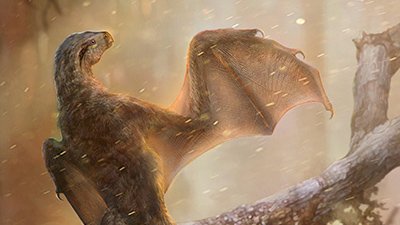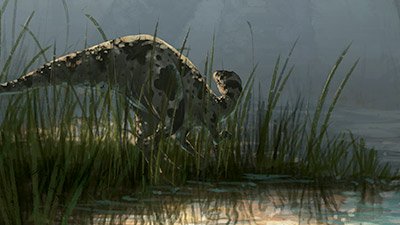
A Vegetarian Dinosaur's Big Mouth
Researchers are confused as to what a giant, duck-billed, many-toothed dinosaur would eat.
News Source
- BBC News: “Duck-billed Dinosaur Had Big Bite”
Trips to the dentist might have been out of the question for the 800-toothed Gryposaurus monumentensis, a two-legged dinosaur discovered in Utah in 2004. The dinosaur’s 800 teeth lined a “very large, strong jaw and beak,” explains the Utah Museum of Natural History’s Terry Gates, one of the authors in a recent Zoological Journal of the Linnean Society study of the creature.
Gryposaurus is the “Arnold Schwarzenegger of duckbilled dinosaurs,” adds Scott Sampson, another Utah Museum paleontologist who contributed to the study. In addition to the dinosaur’s “powerful, strengthened jaw,” it boasted a length of more than 30 ft (10 m).
Frightening as it may sound, though, the scientists describe Gryposaurus as a “very formidable plant eater that “could have sliced through large amounts of fibrous or woody plant material.” However, the researchers are not entirely certain what the dinosaur’s diet was:
“We just don’t know what this dinosaur ate,” [Gates] said.
But whilst the food preferences of the toothy Gryposaurus monumentensis remain a mystery, the diet of other creatures alive at the time do not.
Interestingly, this brings to mind the attacks evolutionists (and compromisers) levy against the Bible’s teaching that all animals were created as vegetarian (Genesis 1:30). Often, animals whose jaws and teeth appear to be suited for eating meat are instead mostly or exclusively plant-eaters, as in the case of the giant panda and certain types of bats and bears; here, the toothy, powerful-jawed Gryposaurus has been categorized as plant eating as well, based on its genus (although its diet is unknown). The argument that certain creatures, such as T. rex, just “couldn’t have been” vegetarian before the Fall is contradicted by creatures we know are plant eating, despite teeth and jaws that appear ferocious. Furthermore, our current uncertainty about what Gryposaurus ate is a refreshingly candid admission that it is difficult/many times impossible to know exactly what happened in the past (particularly what animals ate in Eden) without relying on an eyewitness (which we have in God’s Word: the Creator).
Further Reading
For More Information: Get Answers
Remember, if you see a news story that might merit some attention, let us know about it! (Note: if the story originates from the Associated Press, FOX News, MSNBC, the New York Times, or another major national media outlet, we will most likely have already heard about it.) And thanks to all of our readers who have submitted great news tips to us. If you didn’t catch all the latest News to Know, why not take a look to see what you’ve missed?
(Please note that links will take you directly to the source. Answers in Genesis is not responsible for content on the websites to which we refer. For more information, please see our Privacy Policy.)
Recommended Resources

Answers in Genesis is an apologetics ministry, dedicated to helping Christians defend their faith and proclaim the good news of Jesus Christ.
- Customer Service 800.778.3390
- Available Monday–Friday | 9 AM–5 PM ET
- © 2025 Answers in Genesis




